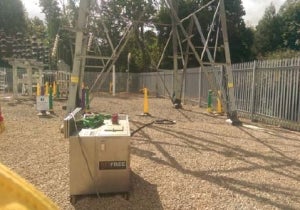
Oxifree UK were asked to partake in a trial coating of the concrete ‘muffs’ at the base of electricity pylons to provide an environmentally safe, long term protection to the concrete.
The ‘muff’ is a thick concrete support that bares the weight of the pylon and is the interface between the pylon and the earth. Historically, the muffs have been coated in bitumen, which is dangerous for livestock / the environment.
Objective
The objective was to provide an alternative to the bitumen paint currently used world over to encase the concrete muff and prevent further capillary action of moisture, which eventually cracks the concrete, leaving the concrete unable to load bare the weight of the pylon.
Oxifree was also selected to coat the legs of the pylon to prevent eventual corrosion of the structure AND can be inspected through.
Process
Step 1 of the process was to obtain approval for use by the Animal Health and Veterinary Laboratories Association (AHVLA) approval for the use of Oxifree within a livestock inhabited environment, which was achieved. The second step was to assess the area and conform, as much as we able, to current standards laid out by and adhered to SSE; a power station in Scotland was selected as the muff already showed signs of degradation and the area was continually manned whereby evaluation of the coated muffs was achievable.
Oxifree visited site, at a timeframe suitable for all involved and completed the coating in one day, whereby the muff was protected and the area deemed safe for livestock and personnel immediately after coating.
Project
The project involved arriving at site with the Oxifree polymelt 50 unit and external generator to provide power, as due to location of the pylon, onsite power was not available.
The area was dug to a depth on 120mm around the concrete (SSE requested 300mm, but due to the hard standing concrete placed within the area after pylon installation, the required depth was not possible, then soft brushed down to remove any wildlife inhabiting the structure, once certain that all wildlife had been removed, the concrete and pylon structure were cleaned using warm water only, to remove dirt and debris build up.
Once dry, an application of Oxifree was commenced at the base of the concrete, up along the pylon upright and along all periphery support beans to a height of approximately 500mm. An application of silicon mastic was applied to the interface to prevent ‘picking’ by curious personnel. Within four hours, the Oxifree technicians had left site allowing normal operation the power station to continue.
For more information, please contact Oxifree.

